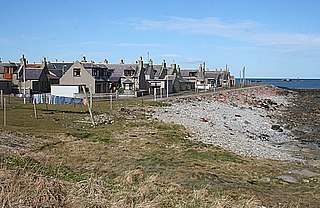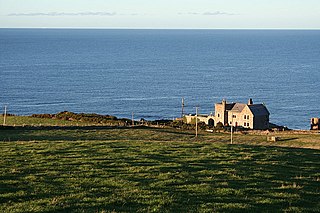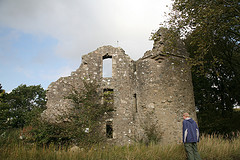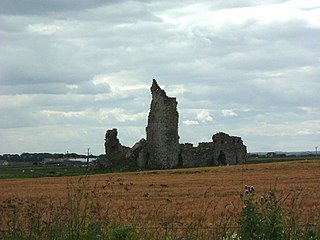
Aberdeenshire is one of the 32 council areas of Scotland.

Fraserburgh is a town in Aberdeenshire, Scotland with a population recorded in the 2011 Census at 13,100. It lies at the far northeast corner of Aberdeenshire, about 40 miles (64 km) north of Aberdeen, and 17 miles (27 km) north of Peterhead. It is the biggest shellfish port in Scotland and one of the largest in Europe, landing over 5,450 tonnes in 2016. Fraserburgh is also a major port for white and pelagic fish.

Kincardineshire, also known as the Mearns, is a historic county, registration county and lieutenancy area on the coast of northeast Scotland. It is bounded by Aberdeenshire on the north and west, and by Angus on the south.

Corgarff Castle is located slightly west of the village of Corgarff, in Aberdeenshire, north-east Scotland. It stands by the Lecht road, which crosses the pass between Strathdon and Tomintoul.

Aberdeenshire or the County of Aberdeen is a historic county and registration county of Scotland. The area of the county, excluding the Aberdeen City council area itself, is also a lieutenancy area. The county borders Kincardineshire, Angus and Perthshire to the south, Inverness-shire and Banffshire to the west, and the North Sea to the north and east. It has a coast-line of 65 miles (105 km). The county gives its name to the modern Aberdeenshire council area, which covers a larger area than the historic county.

The villages of Inverallochy and Cairnbulg lie some 4 miles (6.4 km) east of Fraserburgh, in North East Scotland. It formerly consisted of the three fishing villages of Brandesburgh, Cairnbulg and Inverallochy, but the former village has since disappeared.

Kinnaird Head is a headland projecting into the North Sea, within the town of Fraserburgh, Aberdeenshire, on the east coast of Scotland. The 16th-century Kinnaird Castle was converted in 1787 for use as the Kinnaird Head Lighthouse, the first lighthouse in Scotland to be lit by the Commissioners of Northern Lights. Kinnaird Castle and the nearby Wine Tower were described by W. Douglas Simpson as two of the nine castles of the Knuckle, referring to the rocky headland of north-east Aberdeenshire. The lighthouse is a category A listed building. and the Wine Tower. is a scheduled monument. The buildings around the base of the lighthouse are the work of Robert Stevenson.

The Castle of Rattray was a medieval Scottish castle, with multiple variations on its structure over approximately six centuries. Originally built as a "late 12th- or early 13th century defensive motte" it provided protection for Starny Keppie Harbour and Rattray village. Sometime between 1214 and 1233 it was upgraded by William Comyn, jure uxoris Earl of Buchan before being destroyed in the 1308 Harrying of Buchan. After Comyn's timber castle was burned down, it was replaced by a stronger stone castle which was engulfed during a 1720 sand storm along with nearby Rattray village. After the storm, the castle was not dug out and remains covered to this day. The castle was described by W. Douglas Simpson as one of the nine castles of the Knuckle, referring to the rocky headland of north-east Aberdeenshire.
The remains of the Castle of Lonmay are found near Netherton of Lonmay, to the north of Loch Strathbeg in Buchan, Scotland. The remains are not located in the modern village of Lonmay which is approximately 6 km to the south-west. It was described by W. Douglas Simpson as one of the nine castles of the Knuckle, referring to the rocky headland of North-East Aberdeenshire.

Cairnbulg Castle is a z-plan castle situated in Cairnbulg, Aberdeenshire, Scotland. It was described by W. Douglas Simpson as one of the nine castles of the Knuckle, referring to the rocky headland of north-east Aberdeenshire. It stands by the River Philorth and was originally known as Philorth Castle. The 17th-century Philorth Castle, an L-plan house consisting of a sizeable crow-stepped block, was demolished after a fire in 1915.

Cairnbulg railway station was a station on the Fraserburgh and St Combs Light Railway, Aberdeenshire. It was opened in 1903 as Inverallochy and was renamed Cairnbulg on 1 September 1903.

Dundarg Castle is a ruined castle about 2 kilometres (1.2 mi) north-northeast of New Aberdour, Aberdeenshire, Scotland, built within the ramparts of an earlier Iron Age promontory fort. It was described by W. Douglas Simpson as one of the nine castles of the Knuckle, referring to the rocky headland of North-East Aberdeenshire, and by Charles McKean as "Scotland's answer to Tintagel". It became a small Celtic monastery for a period.

Pitsligo Castle is a ruined castle half a mile east of Rosehearty, Aberdeenshire, Scotland. Modified in the 1570s by the Forbes of Druminnor, it was described by W. Douglas Simpson as one of the nine castles of the Knuckle, referring to the rocky headland of North-East Aberdeenshire. It is listed by Historic Environment Scotland as a scheduled monument.

Esslemont Castle is a ruined tower house in Aberdeenshire, Scotland. It is located on the A920 west of Ellon and is designated a scheduled ancient monument.

Inverallochy Castle is a ruined courtyard castle, near the village of Inverallochy in the Buchan area of North-East Scotland, dating to 1504. It lies 0.5 miles (0.80 km) south of Cairnbulg Castle, near Fraserburgh, and formerly stood beside the now-drained Loch of Inverallochy. It was described by W. Douglas Simpson as one of the nine castles of the Knuckle, referring to the rocky headland of North-East Aberdeenshire.

Castle Forbes is a 19th-century country house in the Scottish baronial architecture style near Alford in Aberdeenshire, Scotland.
Philorth Bridge Halt railway station, not to be confused with Philorth railway station on the old Formartine and Buchan Railway, was a request stop on the Fraserburgh and St Combs Light Railway, Aberdeenshire. It was opened in 1903 as Philorth Bridge Halt and stood just to the east of Philorth Bridge, the Water of Philorth and the lane to Cairnbulg Castle.

Clan Cumming, also known as Clan Comyn, is a Scottish clan from the central Highlands that played a major role in the history of 13th-century Scotland and in the Wars of Scottish Independence. The Clan Comyn was once the most powerful family in 13th-century Scotland, until they were defeated in civil war by their rival to the Scottish throne, Robert the Bruce.
Royal Air Force Fraserburgh, or more simply RAF Fraserburgh, is a former Royal Air Force satellite station located in Aberdeenshire, Scotland, 3.2 miles (5.1 km) south east of Fraserburgh and 12.3 miles (19.8 km) north west of Peterhead.

Pittulie Castle is an oblong tower house probably dating from 1596, half a mile from Pitsligo Castle, Rosehearty, Aberdeenshire, Scotland. It is a scheduled monument. Built by the Frasers of Philorth, it was described by W. Douglas Simpson as one of the nine castles of the Knuckle, referring to the rocky headland of north-east Aberdeenshire.


























